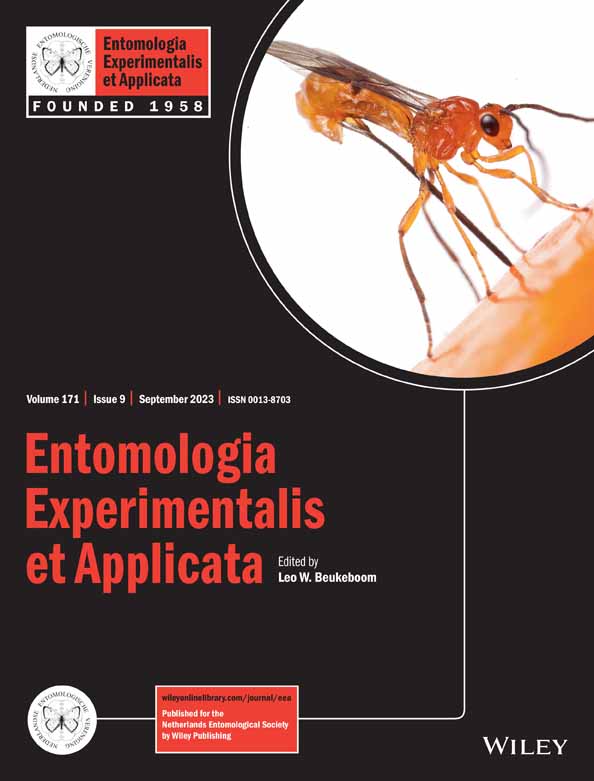Ver ítem
- xmlui.general.dspace_homeCentros e Institutos de InvestigaciónCICVyA. Centro de Investigación en Ciencias Veterinarias y AgronómicasInstituto de Microbiología y Zoología AgrícolaArtículos científicosxmlui.ArtifactBrowser.ItemViewer.trail
- Inicio
- Centros e Institutos de Investigación
- CICVyA. Centro de Investigación en Ciencias Veterinarias y Agronómicas
- Instituto de Microbiología y Zoología Agrícola
- Artículos científicos
- Ver ítem
Molecular detection of reproductive symbionts and parthenogenesis experiments in Tuta absoluta from Argentina: facing potential for sustainable and specific pest control strategies
Resumen
Tomato leafminer, Tuta absoluta (Meyrick) (Lepidoptera: Gelechiidae), is a key pest of tomato crops. Specific and environmentally friendly control strategies against this pest, such as the sterile insect technique (SIT), are under development and sexual reproduction has emerged as a key focal point to ensure its success. In the present study, we analyzed four representative T. absoluta populations from Argentina, focusing on the molecular detection of
[ver mas...]
Tomato leafminer, Tuta absoluta (Meyrick) (Lepidoptera: Gelechiidae), is a key pest of tomato crops. Specific and environmentally friendly control strategies against this pest, such as the sterile insect technique (SIT), are under development and sexual reproduction has emerged as a key focal point to ensure its success. In the present study, we analyzed four representative T. absoluta populations from Argentina, focusing on the molecular detection of endosymbionts potentially associated with reproductive abnormalities and on determining whether parthenogenesis can occur under laboratory conditions. Larvae of T. absoluta were collected in commercial tomato plantations from La Plata and Mar del Plata (both in Buenos Aires province), Bella Vista (Corrientes province), and Yuto (Jujuy province). Tuta absoluta adults were evaluated by standard PCR for the presence of reproductive endosymbionts (Wolbachia sp., Spiroplasma sp., Arsenophonus sp., Cardinium sp., and Rickettsia sp.). For parthenogenesis assays, 20–23 virgin females from each T. absoluta geographic population were life-long isolated in Petri dishes with a tomato leaf. Fecundity, fertility, and female longevity were estimated and compared with results from mated females from each population. Our results showed the presence of a unique endosymbiont (Wolbachia sp. supergroup B, sequence type 41). Fecundity of the unmated females was significantly lower than fecundity of mated females in all T. absoluta populations. In addition, unmated females only laid infertile eggs. In conclusion, the absence of parthenogenesis in T. absoluta from representative geographic populations supports the implementation of SIT and mating disruption as effective control strategies against this pest in Argentina.
[Cerrar]

Autor
Fuente
Entomologia Experimentalis et Applicata 171 : 681-690 (June 2023)
Fecha
2023-06-07
Editorial
Wiley
ISSN
0013-8703
1570-7458
1570-7458
Documentos Relacionados
Formato
pdf
Tipo de documento
artículo
Proyectos
(ver más)
INTA/2019-PE-E4-I074-001, Manejo Integrado de Plagas
INTA/2019-PD-E4-I079-001, Genética, genómica y ecología de insectos de importancia agronómica como insumo para el desarrollo de estrategias sustentables de control plagas
Palabras Claves
Derechos de acceso
Restringido
 Excepto donde se diga explicitamente, este item se publica bajo la siguiente descripción: Creative Commons Attribution-NonCommercial-ShareAlike 2.5 Unported (CC BY-NC-SA 2.5)
Excepto donde se diga explicitamente, este item se publica bajo la siguiente descripción: Creative Commons Attribution-NonCommercial-ShareAlike 2.5 Unported (CC BY-NC-SA 2.5)
Metadatos
Mostrar el registro completo del ítem
Excepto si se señala otra cosa, la licencia del ítem se describe como info:eu-repo/semantics/restrictedAccess
Ítems relacionados
Mostrando ítems relacionados por Título, autor o materia.
-
Manejo de malezas en el cultivo de pecán
Taiariol, Dario (EEA Bella Vista, INTA, 2022-12-15)Una planta no deseada en un lugar no deseado. No siempre invasivas o salvajes. Efectos adversos de malezas. -En plantas jóvenes: Compite y afecta la disponibilidad de nutrientes, luz y agua y, además, alelopatías. - En ... -
Taladrillo de los forestales: algunos aspectos de su biología, detección y manejo de poblaciones
Cichon, Liliana; Garrido, Silvina Alejandra; Lago, Jonatan; Ahmad, Samir (EEA Alto Valle, INTA, 2013)Megaplatypus sulcatus Chapius, conocido vulgarmente como "barreno" o "taladrillo de los forestales", es un coleóptero que produce severos daños en plantaciones forestales y frutales perforando el tronco de los árboles, ... -
Revalorización del Complejo de Depredadores Polífagos Asociado al Cultivo de los Cítricos, Como Agentes de Control Biológico de Plagas Claves
Bouvet, Juan Pedro (Departamento de Producción Vegetal, Universitat Politècnica de València, 2018-12)Dentro de los enemigos naturales de plagas en los agroecosistemas, los depredadores han sido considerados como uno de los grupos de mayor importancia. Sin embargo, su compleja biología y comportamiento ha obstaculizado en ...


